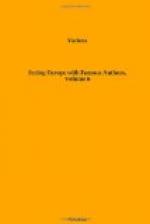In a garden flooded with sunshine and balmy with the fragrance of mignonette and vervain, where broad sunflowers erect their black discs fringed with gold, two brothers with fan-shaped beards, their brass-mounted spectacles astride on their flat noses, and arrayed in green gardening aprons, are plying enormous watering-cans; while, in the green and cool half-twilight under the shadowy trees, big, rubicund brothers walk up and down, reading their red-edged breviaries in black leather bindings.
Happy monks! Not a fraction of a pessimist among them! How well they understand life! A beautiful convent, beautiful nature, good wine and good cheer, neither disturbance nor care; neither wife nor children; and when they leave the world, heaven specially created for them, seraphim waiting for them with harps of gold, and angels with urns of rose-water to wash their feet!
Lucerne began as a nest of monks, hidden in an orchard like a nest of sparrows. The first house of the town was a monastery, erected by the side of the lake. The nest grew, became a village, then a town, then a city. The monks of Murbach, to whom the monastery of St. Leger belonged, had got into debt; this sometimes does happen even to monks. They sold to King Rudolf all the property they possest at Lucerne and in Unterwalden; and thus the town passed into the hands of the Hapsburgs.
When the first Cantons, after expelling the Austrian bailiffs, had declared their independence, Lucerne was still one of Austria’s advanced posts. But its people were daily brought into contact with the shepherds of the Forest Cantons, who came into the town to supply themselves with provisions; and they were not long in beginning to ask themselves if there was any reason why they should not be, as well as their neighbors, absolutely free. The position of the partizans of Austria soon became so precarious that they found it safe to leave the town....
The opening of the St. Gothard Railway has given a new impulse to this cosmopolitan city, which has a great future before it. Already it has supplanted Interlaken in the estimation of the furbelowed, fashionable world—the women who come to Switzerland not to see but to be seen. Lucerne is now the chief summer station of the twenty-two Cantons. And yet it does not possess many objects of interest. There is the old bridge on the Reuss, with its ancient paintings; the Church of St. Leger, with its lateral altars and its Campo Santo, reminding us of Italian cemeteries; the museum at the Town Hall, with its fine collection of stained glass; the blood-stained standards from the Burgundian wars, and the flag in which noble old Gundolfingen, after charging his fellow-citizens never to elect their magistrates for more than a year, wrapt himself as in a shroud of glory to die in the fight; finally, there is the Lion of Lucerne; and that is all.
The most wonderful thing of all is that you are allowed to see this lion for nothing; for close beside it you are charged a franc for permission to cast an indifferent glance on some uninteresting excavations, which date, it is said, from the glacial period. We do not care if they do....




